How-the-world-eats-世界美食-、饮食文化、饮食差异、餐桌礼仪
- 格式:ppt
- 大小:6.33 MB
- 文档页数:35
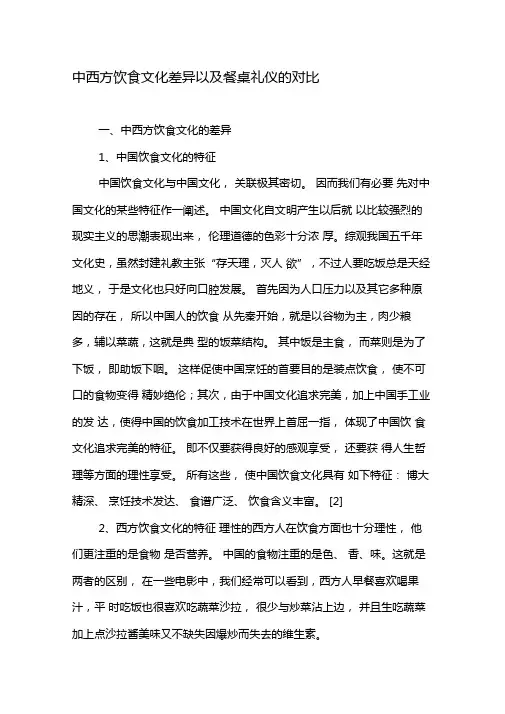
中西方饮食文化差异以及餐桌礼仪的对比一、中西方饮食文化的差异1、中国饮食文化的特征中国饮食文化与中国文化,关联极其密切。
因而我们有必要先对中国文化的某些特征作一阐述。
中国文化自文明产生以后就以比较强烈的现实主义的思潮表现出来,伦理道德的色彩十分浓厚。
综观我国五千年文化史,虽然封建礼教主张“存天理,灭人欲”,不过人要吃饭总是天经地义,于是文化也只好向口腔发展。
首先因为人口压力以及其它多种原因的存在,所以中国人的饮食从先秦开始,就是以谷物为主,肉少粮多,辅以菜蔬,这就是典型的饭菜结构。
其中饭是主食,而菜则是为了下饭,即助饭下咽。
这样促使中国烹饪的首要目的是装点饮食,使不可口的食物变得精妙绝伦;其次,由于中国文化追求完美,加上中国手工业的发达,使得中国的饮食加工技术在世界上首屈一指,体现了中国饮食文化追求完美的特征。
即不仅要获得良好的感观享受,还要获得人生哲理等方面的理性享受。
所有这些,使中国饮食文化具有如下特征:博大精深、烹饪技术发达、食谱广泛、饮食含义丰富。
[2]2、西方饮食文化的特征理性的西方人在饮食方面也十分理性,他们更注重的是食物是否营养。
中国的食物注重的是色、香、味。
这就是两者的区别,在一些电影中,我们经常可以看到,西方人早餐喜欢喝果汁,平时吃饭也很喜欢吃蔬菜沙拉,很少与炒菜沾上边,并且生吃蔬菜加上点沙拉酱美味又不缺失因爆炒而失去的维生素。
二、中西餐桌礼仪方面的差异1、位置安排礼仪中西方都讲究宴请的座位安排。
中国的入座的礼仪是先请客人入座上席,一般先请年长者就坐根据辈分依次入座,中国人比较在意座位的安排,因为这个也象征的权利和地位,一般受重视的或者地位道高权重的会上上座,就像我们看古装剧的时候,一般来了尊贵的客人,主人都会说:“来来,请上座。
”当我们入座时要从椅子左边进入,入座后不要动筷子,也不要弄出响声来更不要到处随便走来走去,如果有什么事要向主人打招呼;西方的入座礼仪也是从左侧入座,当椅子被拉开后,身体在几乎要碰到桌子的距离站直,领位者会把椅子推进来,腿弯碰到后面的椅子时,就可以坐下来了,这个场景我们也可以经常从电影里看到,西方绅士的男生和美丽的女士去约会就餐的时候,都会很绅士的拉开椅子让女士就座。
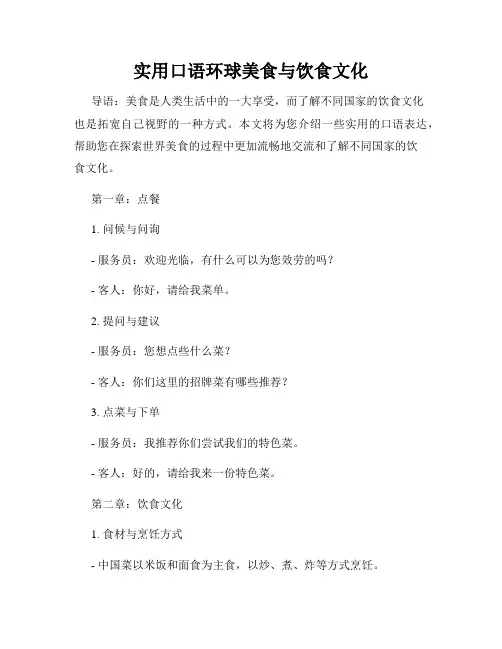
实用口语环球美食与饮食文化导语:美食是人类生活中的一大享受,而了解不同国家的饮食文化也是拓宽自己视野的一种方式。
本文将为您介绍一些实用的口语表达,帮助您在探索世界美食的过程中更加流畅地交流和了解不同国家的饮食文化。
第一章:点餐1. 问候与问询- 服务员:欢迎光临,有什么可以为您效劳的吗?- 客人:你好,请给我菜单。
2. 提问与建议- 服务员:您想点些什么菜?- 客人:你们这里的招牌菜有哪些推荐?3. 点菜与下单- 服务员:我推荐你们尝试我们的特色菜。
- 客人:好的,请给我来一份特色菜。
第二章:饮食文化1. 食材与烹饪方式- 中国菜以米饭和面食为主食,以炒、煮、炸等方式烹饪。
- 法国菜以面包和奶酪为主食,以烤、炖、炸等方式烹饪。
2. 餐桌礼仪- 在中国,用筷子进食时应注意不要直接用嘴巴接触筷子。
- 在法国,进食时应使用刀叉,不要用手抓食物。
3. 用餐时间- 中国人一般会在中午和晚上吃两顿大餐。
- 法国人通常会用午餐和晚餐来享受美食的时间。
第三章:美食推荐1. 中国美食- 麻婆豆腐:麻辣鲜香的豆腐菜肴,是川菜中的经典之作。
- 糖醋里脊:酸甜可口的猪肉菜肴,是江苏菜的代表之一。
2. 法国美食- 波尔多牛排:外焦里嫩的牛排,是法国著名的肉类菜品。
- 奶油蜗牛:以法国著名的田螺为主料,搭配奶油烹制而成的美食。
3. 其他国家美食- 寿司(日本):以生鱼片和米饭为主要原料的一道传统日本菜品。
- 意大利面(意大利):以面粉为主要原料制作的一种烹饪风格。
结语:通过学习实用口语,我们可以更好地了解和体验不同国家的美食与饮食文化。
希望这些口语表达对您探索世界美食之旅有所帮助,享受您的美食之旅!。
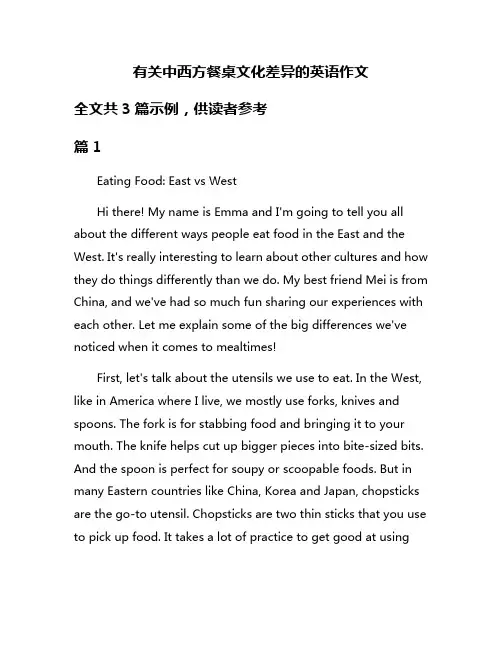
有关中西方餐桌文化差异的英语作文全文共3篇示例,供读者参考篇1Eating Food: East vs WestHi there! My name is Emma and I'm going to tell you all about the different ways people eat food in the East and the West. It's really interesting to learn about other cultures and how they do things differently than we do. My best friend Mei is from China, and we've had so much fun sharing our experiences with each other. Let me explain some of the big differences we've noticed when it comes to mealtimes!First, let's talk about the utensils we use to eat. In the West, like in America where I live, we mostly use forks, knives and spoons. The fork is for stabbing food and bringing it to your mouth. The knife helps cut up bigger pieces into bite-sized bits. And the spoon is perfect for soupy or scoopable foods. But in many Eastern countries like China, Korea and Japan, chopsticks are the go-to utensil. Chopsticks are two thin sticks that you use to pick up food. It takes a lot of practice to get good at usingthem! Mei taught me how and at first I dropped so many peas on the floor. But now I'm a chopstick pro.Another big difference is how the food is served. In Western meals, each person usually gets their own plate with their meal already plated for them. So if I order chicken nuggets, they'll come already on my plate. But in the East, there are often shared dishes in the middle of the table that everyone takes from. So there might be a plate of dumplings or a bowl of fried rice that we all take a portion from using our chopsticks or spoon. It's a much more communal way of eating where you share from the same plates. I like that because then I get to try a little bit of everything!Speaking of sharing, in the West we tend to eat our food course by course. So we'll have an appetizer, then maybe a soup or salad, followed by the main entree, and lastly dessert if we're celebrating something special. It's very spread out over time. But in Eastern meals, everything comes out at once - all the appetizers, main dishes and sides are placed on the table at the same time. That way you can sample and nibble on different dishes as you go. I have to say, I prefer this Eastern way because I'm always too impatient to wait for each course!The types of foods are quite different too. A lot of Western food contains meat like beef, chicken or pork as the main protein. We also eat a lot of bread, cheese, and potatoes as side dishes. But in the East, the main proteins are more likely to be seafood, tofu or eggs. And instead of bread and potatoes, they'll have rice, noodles or dumplings as staple starches. Don't get me wrong - I love a good hamburger! But I have become a big fan of stir-fries, sushi and all the interesting veggie dishes we get to try in Eastern cuisine.Table manners are a little different too. In Western culture, it's considered rude to burp, slurp your food or make loud chewing noises. We're taught to eat quietly with our mouths closed. But in many Eastern cultures, slurping your noodles or letting out a burp after a meal is no big deal - in fact, it can even be a compliment to the chef that you enjoyed the food so much! At first it seemed weird to me, but now I think it's just a different way of expressing appreciation.One last major difference is that in the West, we tend to eat at a set meal time - like dinner is usually around 6 or 7 pm. But in the East, meals are more flexible and can be eaten over a longer period of time, with people coming and going from the table as they get hungry. Mei's family will often leave the dishes out onthe table for hours, snacking here and there. No one tells them they have to finish their plate or can't start eating until the whole family is seated. It's a much more relaxed way of doing meals!So those are the biggest differences I've noticed between Eastern and Western dining culture. From the utensils to the table manners to how the meals are structured, there are so many fascinating contrasts. I feel lucky to have experienced both ways of eating. Mei and I have had the best time learning about each other's food traditions and customs. It's really opened my eyes to see how people in different parts of the world live their day-to-day lives. Ultimately, food is much more than just feeding your hunger - it's about bringing people together, celebrating your heritage, and making memories around the table. No matter where you're from, isn't that what mealtimes are all about?篇2Eating Across CulturesHave you ever wondered why your family eats differently than your friends' families? Maybe you've noticed some fun and interesting differences between how meals happen at your house compared to other houses you've visited. For me, I'vealways been really curious about the different dining traditions and customs around the world. You see, my family is from China, but many of my closest friends have families from the United States, Mexico, India, and other places. I've paid close attention over the years, and I've spotted some super cool differences in how we eat that I want to share with you!First, let's talk about the basics – like utensils. In my Chinese family, we always use chopsticks to eat. Chopsticks are two skinny sticks, usually made of wood or plastic, that we hold in one hand to pick up food. Using chopsticks is kind of like using tiny tongs to grab your food and bring it to your mouth. It takes a little practice to get good with chopsticks, but once you've got it down, it's really fun! A lot of my American friends, on the other hand, use forks, spoons, and knives. These seem to be the standard utensils in many Western cultures.Another big difference is the way meals are served. In China, we have what's called "family style" dining. That means that all the different dishes get placed in the center of the table, and everyone shares from those main plates by taking portions with their chopsticks onto their own individual plate. So we pass the food around and people can pick what they want from the shared dishes. But many of my friends who aren't from Chinesefamilies eat very differently – their parents often plate and serve each person an individual meal already portioned out just for them. Wild, right?Speaking of shared dishes, something I've observed is that portion sizes tend to be a bit smaller in China compared to the United States. Chinese meals usually have lots of different dishes with smaller servings of each item. That way, you can sample and share many different flavors and dishes. But I've been to friends' houses where the portion sizes are massive – like one single serving could probably feed three people! My parents have explained that in America, portions are often really big. Maybe it has something to do with all the amazing choice and abundance of food available.The rhythm and timing of meals is another fascinating difference. In my home, we spend a very long time at the dinner table just enjoying each other's company, the food, and good conversation. Dinner is a big, awesome event that we never rush through. We take our time eating different courses and dishes, and chatting throughout the experience. But I've noticed some of my friends will come home from school and their families just grab a quick solo meal or snack, and then everyone goes their separate ways. No long, dragged out family dinner times. Just afast bite and they're off to other activities right away. I've got to say, I really cherish those dinner traditions of slowing down, being together, and appreciate the meal.You know what else is distinct about Chinese meals? We tend to drink lots of hot beverages during the meal, like piping hot jasmine tea. But at plenty of my friends' houses, I've seen big glasses of ice water or cold beverages like milk or juice on the table. Having a burning hot drink with a meal seemed so bizarre to me at first! I'm just so accustomed to my parents telling me not to drink cold liquids while eating because they believe it's bad for the digestion process.One other big difference has to do with when and how we use hands versus utensils to eat. In my culture, it's considered polite to use chopsticks or utensils for everything, even foods that are handheld in other cultures like pizza, burgers, or tacos. But I've been to birthday parties and other events where my friends will happily pick up foods like that with their hands. At my household, getting your hands greasy and eating with your fingers would be seen as sloppy manners. Just goes to show how different cultures can view those habits so differently!Finally, I have to mention one other obvious contrast – the types of cuisines and dishes we eat! In China, there are so manyfamous dishes and regional specialties that you could spend years trying to sample them all. Things like dumplings, noodles, rice dishes, stir-fries with vegetables and proteins, hot pots, and so much more. Many of these items and flavors taste very different from the typical American foods and cuisines that my friends eat like hamburgers, pizza, tacos, sandwiches, and the like. But you know what? I absolutely love getting to experience and appreciate all the different incredible culinary traditions this world has to offer. It's been so fun getting to taste my way through my friends' cultures while also being proud to share my own heritage's amazing foods and customs.All in all, I feel really fortunate to have been exposed to so many fascinating dining traditions from a young age. It's given me such an appreciation for the beautiful diversity in how humans eat, bond over meals, and pass down food rituals from one generation to the next. While the specifics look quite different, I've realized that sharing food is ultimately about bringing people together across cultures and focusing on what we all have in common – a love of tasty things to eat and quality time spent bonding with loved ones. Those are some super valuable lessons that I've gotten to learn through experiencing all these different mealtime traditions firsthand. I can't wait tosee what other cool food cultures I get to explore as I travel more of this delicious world!篇3Eating Across CulturesFood is such an important part of life. We all need to eat to survive and grow big and strong. But did you know that different cultures around the world have very different ways of eating and thinking about food? I find the differences between how my family eats at home and how other families eat to be really fascinating!At my house, we eat a lot of Chinese food like rice, noodles, dumplings, and stir-fries. My grandparents emigrated here from China, so they brought all their delicious recipes and traditions with them. Whenever we have a big family meal, there are lots of different dishes served all at once. We each get a small bowl of rice, and then we use our chopsticks to take bites from the shared dishes in the middle of the table. There's almost always a soup, a vegetable dish, and then maybe a meat or seafood dish. I love dipping my dumplings in the soup!My best friend Emily's family is from Italy, and they do things quite differently at their house. Instead of having lots of dishes toshare, each person gets a big plate with just one main entree. Emily's mom always makes a vegetable side dish and sometimes bread too. But the main course is definitely the star - things like chicken parmesan, spaghetti and meatballs, or baked eggplant. They use forks and spoons instead of chopsticks too.I remember when I went over to Emily's house for dinner for the first time, I was so confused. There was only one big plate in front of me instead of the lazy susan full of shared dishes I was used to. Emily's little brother saw me looking puzzled and he laughed at me! "You eat it all yourself, silly," he said. Emily's parents thought it was pretty funny that I didn't know you're supposed to eat the whole plate by yourself in their culture.But you know what? Eating with chopsticks to pick up bites of different dishes is pretty weird for them too! Emily always gets a huge kick out of watching me use my chopsticks at lunchtime. She says it looks like I'm playing pick-up sticks with my food. One time she even tried using my chopsticks and managed to fling a mushroom clear across the cafeteria! We both cracked up laughing so hard.I've noticed there are other big differences in how our families do mealtimes too. In my family, we always say thanks and appreciate the food before eating. My mom reminds us thatsomeone worked hard to grow the ingredients and prepare the meal, so we shouldn't be wasteful. At Emily's house, they say a prayer before eating to thank God for the food instead.Another thing I find really interesting is that my family drinks stuff like tea, hot chocolate, or room temperature water with our meals. But Emily's family always has big glasses of ice water or milk with dinner. I remember gulping down some ice-cold milk at her house once and I got such a headache from the brain freeze! Now I know to take tiny sips.Dessert is different too. My family doesn't eat dessert with every meal - it's more of a sometimes treat. When we do have something sweet, it's usually just a little bite like fresh fruit or a couple bites of ice cream. Emily's family has big desserts like cake, pie, or cookies after almost every dinner though! One time they even had chocolate lava cakes AND ice cream sundaes. I was completely stuffed but somehow managed to eat both - they were too delicious to resist.You know, food is such an interesting window into how cultures around the world are alike and different. Even though certain traditions feel really weird or surprising at first, I've learned that it's just a matter of what you're accustomed to. NowI don't bat an eye when Emily picks up her fork or when I have to use a spoon. We just laugh about the funny differences.In the end, food is about sharing, nourishment, and appreciating other cultures as much as our own. Trying my friends' family's traditional dishes has opened my eyes to all sorts of new flavors I never knew about before. And you better believe they get just as excited to dig into my grandma's dumplings or Peking duck! The world has so many tasty things to offer. I feel really lucky that through food, I get to experience little bits of other cultures. It's like getting to go on around-the-world adventure, but just by eating!。
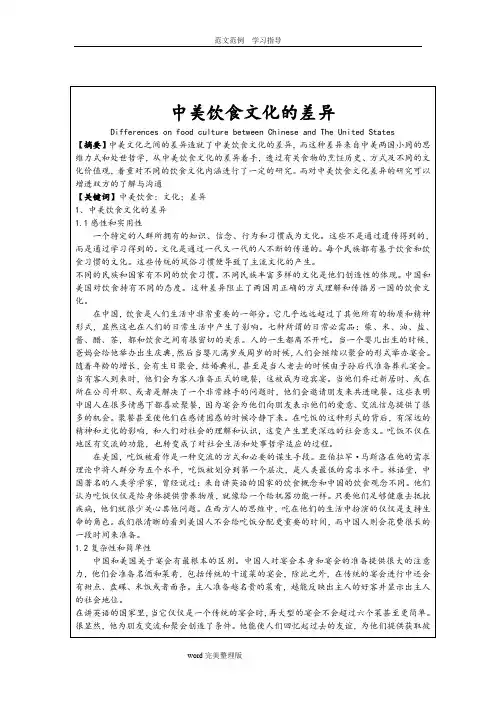
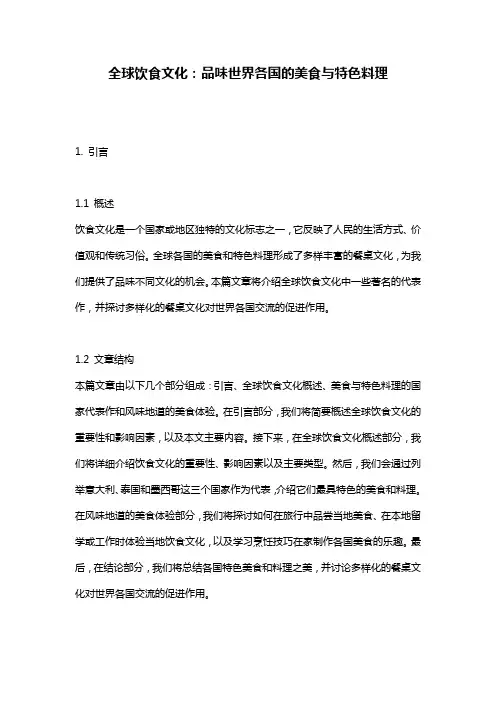
全球饮食文化:品味世界各国的美食与特色料理1. 引言1.1 概述饮食文化是一个国家或地区独特的文化标志之一,它反映了人民的生活方式、价值观和传统习俗。
全球各国的美食和特色料理形成了多样丰富的餐桌文化,为我们提供了品味不同文化的机会。
本篇文章将介绍全球饮食文化中一些著名的代表作,并探讨多样化的餐桌文化对世界各国交流的促进作用。
1.2 文章结构本篇文章由以下几个部分组成:引言、全球饮食文化概述、美食与特色料理的国家代表作和风味地道的美食体验。
在引言部分,我们将简要概述全球饮食文化的重要性和影响因素,以及本文主要内容。
接下来,在全球饮食文化概述部分,我们将详细介绍饮食文化的重要性、影响因素以及主要类型。
然后,我们会通过列举意大利、泰国和墨西哥这三个国家作为代表,介绍它们最具特色的美食和料理。
在风味地道的美食体验部分,我们将探讨如何在旅行中品尝当地美食、在本地留学或工作时体验当地饮食文化,以及学习烹饪技巧在家制作各国美食的乐趣。
最后,在结论部分,我们将总结各国特色美食和料理之美,并讨论多样化的餐桌文化对世界各国交流的促进作用。
1.3 目的本篇文章的目的是让读者了解全球饮食文化的重要性、影响因素以及不同国家代表性的美食和特色料理。
通过了解不同文化的饮食习惯和传统菜肴,人们可以更好地欣赏世界上不同国家和地区独特的餐桌文化,并促进跨文化交流与理解。
同时,本文还提供了一些具体方法来亲身体验不同国家的美食和料理,以便读者能够更深入地参与其中。
通过阅读本文,读者将有机会扩展自己对世界各国饮食文化的认知,并通过品味各种美食来感受不同地方所带来的独特魅力。
2. 全球饮食文化概述2.1 饮食文化的重要性饮食文化在人类社会中扮演着重要角色。
它不仅是满足人们基本生理需求的一种方式,还代表了一个国家或地区的文化特色和传统价值观。
饮食文化可以通过食物的准备、烹饪、享用方式以及与社交活动的结合来展现出来。
无论是日常就餐还是节日庆祝,各国饮食文化都能反映出对美食和烹饪技巧的追求,讲述着人们历史和生活方式的故事。

本文部分内容来自网络整理所得,本司不为其真实性负责,如有异议或侵权请及时联系,本司将立即予以删除!== 本文为word格式,下载后可方便编辑修改文字! ==东西方餐桌礼仪英文版导语:餐桌礼仪对你我都非常重要,它在中国人的生活秩序中占有一个非常重要的地位。
以下小编为大家介绍东西方餐桌礼仪英文版文章,欢迎大家阅读参考!东西方餐桌礼仪英文版BackgroundAlong with the development of global economy, cross-culture communication has become more and more frequent, and the differences between Chinese and western culture have become more obvious, especially the differences of table manners.全球经济的发展,跨文化交际日益频繁,中西文化差异变得更加明显,特别是餐桌礼仪的差异。
In ChinaGenerally, seats that closer to the top table take precedence. For example, on the wedding party, family members of the bride or the leaderships are arranged to the table that closest to the top table. Hosts show their reverences to the guests by arranging seats by this way.一般来说,座位接近顶部表优先。
例如:在婚礼上,家庭成员或新娘的领导人在排列表最接近顶部的位置。
通过这种安排座位的方法来显示主人对客人的尊重。
Seats at one table also have different meanings. In Chinese table manner, the seat opposite to the door is the honor seat, which is for chief guests or elders; the seats beside are the second honor seat which are for other guests; the seats that opposite to the honor seat are the inferior seat. Inferior seats are for the host and hostess.在中国餐桌文化中,位于门对面的位置是最尊贵的,这个位置是给高贵的客人或者长者。
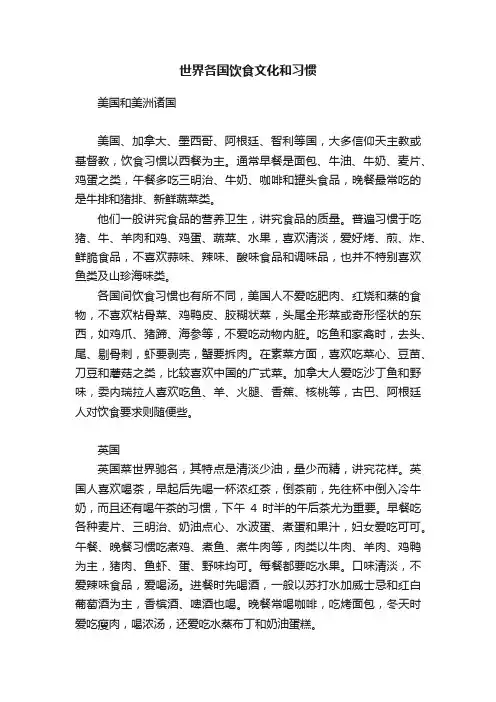
世界各国饮食文化和习惯美国和美洲诸国美国、加拿大、墨西哥、阿根廷、智利等国,大多信仰天主教或基督教,饮食习惯以西餐为主。
通常早餐是面包、牛油、牛奶、麦片、鸡蛋之类,午餐多吃三明治、牛奶、咖啡和罐头食品,晚餐最常吃的是牛排和猪排、新鲜蔬菜类。
他们一般讲究食品的营养卫生,讲究食品的质量。
普遍习惯于吃猪、牛、羊肉和鸡、鸡蛋、蔬菜、水果,喜欢清淡,爱好烤、煎、炸、鲜脆食品,不喜欢蒜味、辣味、酸味食品和调味品,也并不特别喜欢鱼类及山珍海味类。
各国间饮食习惯也有所不同,美国人不爱吃肥肉、红烧和蒸的食物,不喜欢粘骨菜、鸡鸭皮、胶糊状菜,头尾全形菜或奇形怪状的东西,如鸡爪、猪蹄、海参等,不爱吃动物内脏。
吃鱼和家禽时,去头、尾、剔骨刺,虾要剥壳,蟹要拆肉。
在素菜方面,喜欢吃菜心、豆苗、刀豆和蘑菇之类,比较喜欢中国的广式菜。
加拿大人爱吃沙丁鱼和野味,委内瑞拉人喜欢吃鱼、羊、火腿、香蕉、核桃等,古巴、阿根廷人对饮食要求则随便些。
英国英国菜世界驰名,其特点是清淡少油,量少而精,讲究花样。
英国人喜欢喝茶,早起后先喝一杯浓红茶,倒茶前,先往杯中倒入冷牛奶,而且还有喝午茶的习惯,下午4时半的午后茶尤为重要。
早餐吃各种麦片、三明治、奶油点心、水波蛋、煮蛋和果汁,妇女爱吃可可。
午餐、晚餐习惯吃煮鸡、煮鱼、煮牛肉等,肉类以牛肉、羊肉、鸡鸭为主,猪肉、鱼虾、蛋、野味均可。
每餐都要吃水果。
口味清淡,不爱辣味食品,爱喝汤。
进餐时先喝酒,一般以苏打水加威士忌和红白葡萄酒为主,香槟酒、啤酒也喝。
晚餐常喝咖啡,吃烤面包,冬天时爱吃瘦肉,喝浓汤,还爱吃水蒸布丁和奶油蛋糕。
法国法国的烹调技术和菜肴居欧洲之首,以西餐为主,法国菜是西式菜中最考究的,以美味可口,品种繁多著称。
法国菜选料广泛,用料新鲜,烹调讲究,口味喜欢肥嫩、鲜美、浓郁,喜食猪肉、牛肉、羊肉、家禽、香肠、蛋类、鱼虾、蜗牛、牡蛎和新鲜的蔬菜、水果等。
法国的干鲜奶酪是世界闻名的,它们是法国人午餐和晚餐常吃的食品。
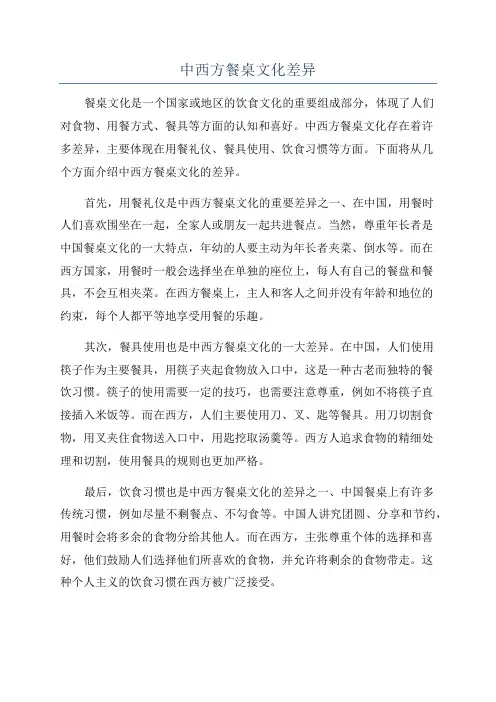
中西方餐桌文化差异餐桌文化是一个国家或地区的饮食文化的重要组成部分,体现了人们对食物、用餐方式、餐具等方面的认知和喜好。
中西方餐桌文化存在着许多差异,主要体现在用餐礼仪、餐具使用、饮食习惯等方面。
下面将从几个方面介绍中西方餐桌文化的差异。
首先,用餐礼仪是中西方餐桌文化的重要差异之一、在中国,用餐时人们喜欢围坐在一起,全家人或朋友一起共进餐点。
当然,尊重年长者是中国餐桌文化的一大特点,年幼的人要主动为年长者夹菜、倒水等。
而在西方国家,用餐时一般会选择坐在单独的座位上,每人有自己的餐盘和餐具,不会互相夹菜。
在西方餐桌上,主人和客人之间并没有年龄和地位的约束,每个人都平等地享受用餐的乐趣。
其次,餐具使用也是中西方餐桌文化的一大差异。
在中国,人们使用筷子作为主要餐具,用筷子夹起食物放入口中,这是一种古老而独特的餐饮习惯。
筷子的使用需要一定的技巧,也需要注意尊重,例如不将筷子直接插入米饭等。
而在西方,人们主要使用刀、叉、匙等餐具。
用刀切割食物,用叉夹住食物送入口中,用匙挖取汤羹等。
西方人追求食物的精细处理和切割,使用餐具的规则也更加严格。
最后,饮食习惯也是中西方餐桌文化的差异之一、中国餐桌上有许多传统习惯,例如尽量不剩餐点、不勾食等。
中国人讲究团圆、分享和节约,用餐时会将多余的食物分给其他人。
而在西方,主张尊重个体的选择和喜好,他们鼓励人们选择他们所喜欢的食物,并允许将剩余的食物带走。
这种个人主义的饮食习惯在西方被广泛接受。
综上所述,中西方餐桌文化存在着许多差异。
中西方人的用餐礼仪、餐具使用和饮食习惯都有其独特的特点和传统。
我们应该尊重和理解各种餐桌文化的差异,才能更好地体验和享受不同国家和地区的饮食文化。
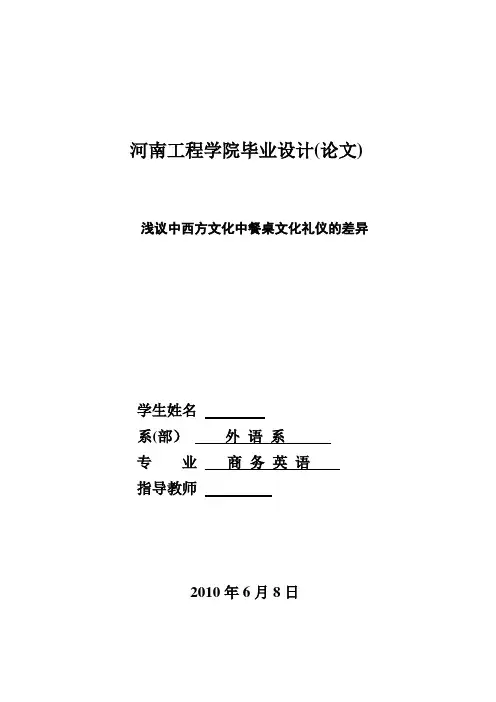
河南工程学院毕业设计(论文) 浅议中西方文化中餐桌文化礼仪的差异学生姓名系(部)外语系专业商务英语指导教师2010年6月8日毕业设计(论文)开题报告毕业设计(论文)任务书教研室主任签字:年月日摘要随着中国对外开放程度的逐渐深入,西方社会的文化越来越多地映入了我们的眼帘。
由于我们所面对的是来自陌生的文化和国家,思维方式、生活习惯和行为方式与我们迥然不同的人,在与之交往的过程中不可避免的会出现文化冲突的现象,严重影响了交往的顺利进行。
餐桌礼仪在交际当中已经占据了重要的地位,学习和运用正确的餐桌礼仪,已不仅仅是自身形象的需要,更是提高双效益、提升竞争力的需要.因此我们很有必要找出其深层次的原因,并提出一定的措施来培养跨文化交际的能力,避免文化冲突。
笔者着重分析了中国与英美等西方国家在餐具使用差异、座次安排差异、就餐氛围差异、及餐桌话语差异四个方面来看跨文化交际中的文化差异,揭示了导致饮食文化差异的深层次的原因,并阐明了随着跨文化交际的发展,中西饮食文化的交流能够在跨文化交际中恰当地、得体地进行交际。
关键词:文化差异餐桌礼仪跨文化AbstractWith the development of China’s opening-up, more and more Western culture gets into our sight. As we face with unfamiliar cultures and countries,some inevitable cultural conflicts might happen in the communication, which will seriously affect the contacts being carried out smoothly。
Table manners have a decisive position in the communication between China and Western countries. During communication we will show our best image and avoid cultural conflicts. Learning and using the right etiquette will not only step up our own impression, but also promote the benefit and strife of the company。
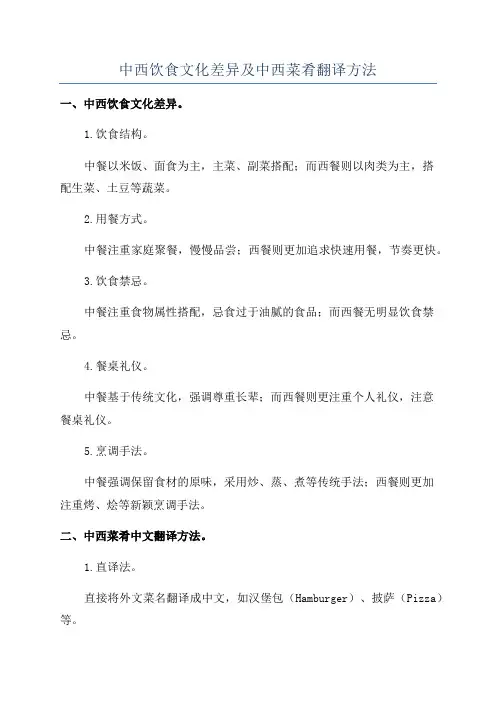
中西饮食文化差异及中西菜肴翻译方法
一、中西饮食文化差异。
1.饮食结构。
中餐以米饭、面食为主,主菜、副菜搭配;而西餐则以肉类为主,搭
配生菜、土豆等蔬菜。
2.用餐方式。
中餐注重家庭聚餐,慢慢品尝;西餐则更加追求快速用餐,节奏更快。
3.饮食禁忌。
中餐注重食物属性搭配,忌食过于油腻的食品;而西餐无明显饮食禁忌。
4.餐桌礼仪。
中餐基于传统文化,强调尊重长辈;而西餐则更注重个人礼仪,注意
餐桌礼仪。
5.烹调手法。
中餐强调保留食材的原味,采用炒、蒸、煮等传统手法;西餐则更加
注重烤、烩等新颖烹调手法。
二、中西菜肴中文翻译方法。
1.直译法。
直接将外文菜名翻译成中文,如汉堡包(Hamburger)、披萨(Pizza)等。
2.音译法。
将外文菜名音译成中文,如意大利面(Spaghetti)、炸鸡(Fried chicken)等。
3.合译法。
将外文菜名的意思和特点结合,进行翻译,如墨西哥卷饼(Burrito)、马来糕(Kuih)等。
4.比喻译法。
将外文菜名比喻成中文文化中的食品,如法国面包(Baguette)翻译为“法棍”,意大利饺子(Ravioli)翻译为“意大利馄饨”等。
5.意译法。
根据菜品的特点和寓意,进行意译,如意大利面(Spaghetti)翻译为“长寿面”,芝士披萨(Cheese pizza)翻译为“奶酪比萨”等。
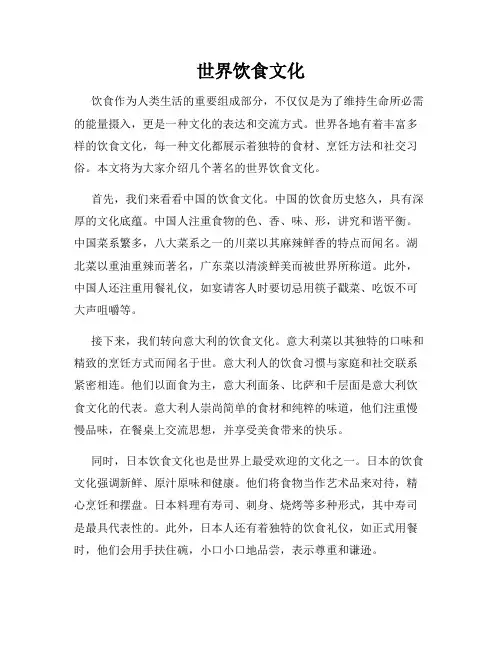
世界饮食文化饮食作为人类生活的重要组成部分,不仅仅是为了维持生命所必需的能量摄入,更是一种文化的表达和交流方式。
世界各地有着丰富多样的饮食文化,每一种文化都展示着独特的食材、烹饪方法和社交习俗。
本文将为大家介绍几个著名的世界饮食文化。
首先,我们来看看中国的饮食文化。
中国的饮食历史悠久,具有深厚的文化底蕴。
中国人注重食物的色、香、味、形,讲究和谐平衡。
中国菜系繁多,八大菜系之一的川菜以其麻辣鲜香的特点而闻名。
湖北菜以重油重辣而著名,广东菜以清淡鲜美而被世界所称道。
此外,中国人还注重用餐礼仪,如宴请客人时要切忌用筷子戳菜、吃饭不可大声咀嚼等。
接下来,我们转向意大利的饮食文化。
意大利菜以其独特的口味和精致的烹饪方式而闻名于世。
意大利人的饮食习惯与家庭和社交联系紧密相连。
他们以面食为主,意大利面条、比萨和千层面是意大利饮食文化的代表。
意大利人崇尚简单的食材和纯粹的味道,他们注重慢慢品味,在餐桌上交流思想,并享受美食带来的快乐。
同时,日本饮食文化也是世界上最受欢迎的文化之一。
日本的饮食文化强调新鲜、原汁原味和健康。
他们将食物当作艺术品来对待,精心烹饪和摆盘。
日本料理有寿司、刺身、烧烤等多种形式,其中寿司是最具代表性的。
此外,日本人还有着独特的饮食礼仪,如正式用餐时,他们会用手扶住碗,小口小口地品尝,表示尊重和谦逊。
除了以上几个国家外,法国的饮食文化也是举世瞩目的。
法国菜以其精致和品味而闻名于世。
法国人喜欢慢慢享受食物,并注重用餐的一系列仪式。
他们崇尚新鲜食材和烹饪技巧,擅长烤、炖和炸等多种烹饪方法。
法国的餐桌上常见的有红酒、奶酪、法棍面包等,这些都是法国饮食文化的重要组成部分。
总结而言,世界各地的饮食文化各具特色,每一种文化都代表着不同国家的历史、地理和风俗习惯。
通过饮食,人们可以了解他们的生活方式、价值观和传统习俗。
无论是中国的川菜、意大利的面食、日本的寿司还是法国的美酒美食,它们都丰富了人们的生活,让食物成为一种跨越国界、建立联系和交流文化的桥梁。
不同国家的食品文化和饮食习惯有何差异?一、餐桌文化的不同不同国家的餐桌文化有着极为显著的差异。
在东方国家,例如中国和日本,餐桌上的菜肴往往十分精致,擅长运用调料和烹饪技巧让食物味道更加丰富。
同时,在饮食过程中,东方国家讲究传统的饮茶文化,认为饮茶可以提神醒脑,消食解腻。
在西方国家,餐桌上的菜肴更加简单朴素,多数以原味呈现,如沙拉、烤肉、烤鱼等,并且喜欢在饮食过程中饮用红酒或啤酒。
二、主食的不同不同国家的主食也有所不同。
在西方国家,主食以面包和土豆为主,特别是在美国和英国,土豆和面包往往是每顿餐饮的必备品。
而在亚洲国家则多数以米饭为主食,例如中国、日本、韩国等国家的人们大部分时间都以米饭为主,主要是因为这些国家耕种的主要农作物是水稻。
除了亚洲国家,非洲也有很多国家的主食为玉米粉,以北非的突尼斯和摩洛哥最为典型。
南美洲的秘鲁人民所食用的传统主食为玉米糊,而墨西哥的马萨玉米饼也在当地广为食用。
三、饮食方式的不同除了菜肴和主食的不同之外,不同国家的饮食方式也有明显的差异。
在肉类方面,西方国家倾向于以烤肉的方式食用,而亚洲国家则喜欢将肉类切块后涮在高汤中食用,又称火锅。
在调味方面,西方国家多数依靠盐、黑胡椒、辣椒粉等传统调味品,而亚洲国家则擅长运用酱油、花椒、姜葱等传统调料,加以烹饪,使得菜肴更加鲜美可口。
四、代表性菜肴的不同不同国家的代表性菜肴也不一样。
在东方国家,中国的烤鸭、日本的寿司、韩国的泡菜等菜肴在国际上都享有很高的声誉。
而在西方国家,披萨、汉堡包以及鱼薯等菜肴则大名鼎鼎,成为了代表性的美食。
五、餐桌礼仪的不同不同国家的餐桌礼仪也有所不同。
在东方国家,餐桌礼仪相对见多识广,如伸筷、夹菜等。
而在西方国家,餐桌礼仪相对简单,主要注意对酒水的礼仪以及使用刀叉等餐具的规范。
综上所述,不同国家的食品文化和饮食习惯之间存在着巨大的差异,但最终都是为了满足人们对于美食的渴望。
通过了解不同国家的烹饪技巧、食材搭配和餐桌礼仪等方面,我们可以更好地领略全球美食的神奇与魅力。
中外饮食文化之差异饮食是人类生存与发展的第一需要,也是社会生活的基本形式之一。
然而不同的文化背景,有不同的饮食观念和饮食习俗,最终形成不同的饮食文化。
饮食文化,实际上是指人在一定历史或社会条件下形成的饮食生活方式以及在此基础上的思想精神范畴。
各个国家和民族在历史发展过程中,由于自然条件和社会环境不同。
形成各自不同的行为规律和生活方式。
中国饮食文化历史悠久,博大精深,影响深远,风靡世界。
它经历了几千年的历史发展,已成为中华民族的优秀文化遗产、世界饮食文化宝库中的一颗璀璨的明珠。
西方的一些国家曾为一些国家的殖民地,并且汇集着各国的移民,因此这些国家深受各国饮食文化的影响,博采众长,并结合自已的饮食特点,形成精巧专维、自成体系的饮食文化。
中西方饮食文化的差异主要表现在以下几个方面。
(一)饮食观念的差异西方是一种理性的,讲求科学的饮食观念。
他们强调饮食的营养价值,注重食物所含蛋白质、脂肪、热量和维生素的多少,特别讲究食物的营养成分含量是否搭配合宜,卡路里的供给是否恰到好处,以及这些营养成分是否能为进食者充分吸收有无其他副作用,尽量保持食物的原汁和天然营养,而不追求食物的色、香、味、形的完美。
即便是口味千篇一律,甚至味同嚼蜡,他们也会将她吃下去。
西方人吃的是营养,他们很少或几乎不把饮食与精神享受联系起来。
在饮食上反映出一种强烈的实用与功利的目的。
西方人认为,饮食仅是生存的手段,应采用一种更科学,规范和合理的方式。
如他们的中小学校都配有营养师,以保证青少年的营养充足和平衡。
这种科学化、理性化的饮食观念,是值得中餐借鉴的。
但同时这又使西餐在用料上受到极大的局限。
如西方人不吃动物内脏以及一切他们认为没有营养价值的东西。
中国人的饮食强调感性和艺术性,追求饮食的口味感觉,而不注意食物的营养成分,多从“色、香、味、形”等方面来评价饮食的好坏优劣,追求的是一种难以言传的意境。
简单地说,中国人吃的是口味,“味”是中国饮食的魅力所在。
中外餐桌文化差异英语作文九年级全文共3篇示例,供读者参考篇1Dining Around the World: Exploring the Fascinating DifferencesHave you ever thought about how different cultures approach something as basic as eating? As a curious student, I've become fascinated by the unique traditions and etiquette surrounding meals in various parts of the world. Let me take you on a journey to discover the contrasting dining experiences between China and the West.In Chinese culture, the dining table is a sacred place where family bonds are strengthened, and respect for elders is deeply ingrained. It's not just about satisfying hunger; it's a ritual that brings people together. One of the most striking differences is the way we use chopsticks. In the West, forks and knives reign supreme, but in China, the graceful art of chopstick handling is a skill passed down through generations.Imagine a typical Chinese family dinner. The table is laden with an array of dishes, each one carefully prepared with loveand attention to detail. From steaming bowls of fragrant rice to sizzling stir-fries and delicate dumplings, every dish is a labor of love. As we gather around the table, an unspoken hierarchy emerges. The elders are served first, a sign of deep respect and reverence.In contrast, Western dining often follows a more casual and individualistic approach. While family bonds are still cherished, the emphasis is on personal preference and convenience. Meals are sometimes eaten on the go or in front of the television, a concept that might seem strange to traditional Chinese families.One aspect that fascinates me is the way we order and share dishes. In Chinese cuisine, it's customary to order multiple dishes and share them among the entire table. This promotes a sense of community and togetherness, as we savor the diverse flavors and textures together. In the West, however, each person typically orders their own individual meal, with little or no sharing involved.Another difference lies in the way we express gratitude for the food. In Chinese culture, it's common to express appreciation by uttering a heartfelt "chi bao le" (literally meaning "have you eaten enough") to show concern for others' satisfaction. Thissimple phrase carries profound meaning, reflecting thedeep-rooted belief that food is a precious gift to be cherished.Moving beyond the table, the role of tea in Chinese and Western cultures also differs significantly. In China, tea is an integral part of the dining experience, a symbol of hospitality and a means to foster conversation and connection. The intricate rituals surrounding tea preparation and serving are deeply rooted in tradition. In the West, while tea is enjoyed, it often takes a backseat to other beverages like coffee or sodas.Despite these differences, there are also some fascinating similarities. Both cultures value the importance of gathering around the table and sharing meals as a way to strengthen bonds and create lasting memories. Food is not just sustenance; it's a language that transcends borders and brings people together.As a student, exploring these cultural nuances has been an enriching experience. It has taught me to appreciate the diversity that exists in our world and to approach different traditions with an open mind and a spirit of curiosity. Whether it's the delicate art of chopstick handling or the warm embrace of a shared meal, each culture has its own unique way of celebrating the simple act of eating.In conclusion, the differences between Chinese and Western dining cultures are vast, yet they both share a common thread: the belief that food is more than just fuel for the body; it's a celebration of life, a means to connect with loved ones, and a way to honor traditions that have been passed down through generations. So, the next time you sit down for a meal, take a moment to appreciate the rich tapestry of customs and rituals that have shaped the way we dine around the world.篇2Eating at the Dinner Table: A World of DifferencesFood brings people together, but how we eat can be really different across cultures. Having experienced both Chinese and Western dining customs, I've noticed some major contrasts that make mealtimes a fascinating window into cultural values and traditions.In Chinese cuisine, sharing is caring. Dishes are served family-style, with everyone digging their chopsticks into the communal plates. This encourages togetherness and unity as we bond over delicious foods. Meals are lively social affairs filled with constant offering, "Have you tried this?" and "Here, have some more of that." It's a warm, inclusive experience.But in Western-style meals, each person gets their own plate with individualized portions. You mind your own food and it's considered rude to reach over someone's plate uninvited. The focus is on personal space and independence rather than sharing and community. While less chaotic, it can feel quite solitary compared to the lively Chinese dinner party vibe.Then there are the chopsticks versus forks and knives debate. Using chopsticks takes real skill – you have to master the subtle finger techniques to grip and maneuver food properly. It's seen as sophisticated and linking you to ancient cultural roots. Knives and forks seem so clumsy and detached in comparison! But I understand the Western view of chopsticks as difficult utensils only mastered through years of practice.In China, making slurping noises while eating noodles or soup is no big deal – it actually shows you're enjoying the food. But in Western cultures, audible chewing or sloppy eating is considered inappropriate and ill-mannered. As a kid, I remember getting scolded by my parents for slurping my soup when we had guests over for dinner. Such different perspectives on civilized dining etiquette!While Chinese meals involve constantly reaching for shared dishes, the Western approach is more systematic with setcourses. First comes the appetizer, then a pause for the main entrée, followed by a salad course, and finally dessert to top it all off. In contrast, Chinese banquet-style dining is like a constant coming and going of different flavors and textures all merged together. No real sequential order – just a beautiful chaos on the dinner table.Table manners are also expressed through what you do with uneaten scraps. In Western culture, it's seen as dirty and uncivilized to place leftovers or bones back on your plate. But in China, pushing remains to the side of your plate or bowl is no big deal – it's kept very casual and unfussy. This more relaxed attitude reflects the differing perspectives on food and mess.Drinking practices are another area of big contrast. At Chinese meals, you'll often see matching ceramic pot sets used communally for pouring and refilling beverages like tea. But for Western-style dining, it's all about refilling your own glass independently. Having others pour for you would be seen as impolite or even inappropriate in some situations.Let's not forget the exciting birth of "fusion" cuisines where elements of Eastern and Western culinary traditions blend together deliciously. From Asian-inspired tacos to pasta dishes jazzed up with traditional Chinese flavors and ingredients, it'sallowing cultural integration right on our dinner plates. The creative possibilities are endless when you start mixing and matching global influences.Ultimately, mealtimes hold deep cultural significance beyond just what we eat. The rituals, customs, and etiquette surrounding how we dine provide a telling glimpse into societal values. Even as cuisines borrow inspiration across borders, many core differences in dining experiences persist as expressions of cultural identity.For me, straddling these two worlds has been wonderfully enriching. I love the boisterous camaraderie of banquet-style Chinese feasts and the intimacy of gathering around a low table to share lazy Suzans. But I also cherish the sophistication of a multi-course Western meal with its elegant table settings and formalized service. Both cultures' dining traditions hold magic in their own ways – and I'm so lucky to experience the beauty of both bite after bite, meal after meal.篇3Eating Across CulturesHey guys! Today I want to talk about something that's a huge part of all our lives - food! More specifically, I'm going todiscuss the major differences between Chinese and Western dining cultures and etiquette. It's pretty fascinating stuff if you stop to think about it.Let's start with the basics - eating utensils. In China, we primarily use chopsticks, while in the West, knives, forks and spoons are the norm. Using chopsticks is considered more refined and elegant in traditional Chinese culture. It takes skill to master picking up food with those two little sticks! Westerners sometimes find chopsticks tricky to use at first. On the other hand, the multiple utensils used in the West can seem fussy and overly complicated to us.Then there are the fundamental differences in how meals are served and eaten. In China, dishes are usually served all at once, family-style in the center of the table for everyone to share. We just dig right in and grab whatever we want with our chopsticks. But in Western-style dining, each person gets an individual plate with their own servings already portioned out. You have to use your knife to cut your food up before eating it with the fork. So much different from just reaching over with your chopsticks!The pacing of a Chinese meal is more fluid too. We'll nibble on this dish, then that one, going back and forth. Meals can last a long time with continuous snacking and refilling of dishes.Western-style dining feels more structured to me, with defined courses brought out in a set order - appetizer, soup or salad, main course, dessert. You have to eat each course in turn before moving onto the next.Certain eating customs are just polar opposites between the two cultures. For example, at a Chinese dinner, it's considered polite to burp or slurp your food to show you're enjoying it. But those same behaviors would be seen as repulsive bad manners in the West! Likewise, we Chinese often make noise when chewing and don't worry about talking with our mouths full. But in Western etiquette, you absolutely must chew with your mouth closed without making sounds. As kids, we get scolded for that all the time.Speaking of talking at the table, Chinese dining is a much more lively, boisterous affair. We're not as fussy about formalities like strict seating arrangements. Everyone just grabs a spot, digs in, and chit-chats animatedly throughout the meal. But I've noticed Western dining seems a bit more reserved and quiet in comparison. There's an emphasis on good table manners - no loud talking, elbows off the table, napkins in your lap, and so on.Of course, drinking culture at meals is starkly different too. In China, it's very common and acceptable for adults to drinkalcohol like beer or baijiu with meals, even at lunch. In fact, for special celebrations or when entertaining guests, they are almost obligated to drink quite heavily as a sign of hospitality and merriment. My dad likes to drink a few big shots of potent baijiu at family reunion meals. In contrast, having any alcohol at all with a meal is much less common in the West, especially at lunchtime. Excessive drinking wouldn't be considered appropriate in most situations.All in all, these cultural differences just go to show that there's no single "right" way to dine. We all have our own unique traditions, etiquette rules, and perspectives shaped by our backgrounds. Personally, I love the relaxed, casual vibe of Chinese mealtimes where no one has to get fussy about manners. But I can also appreciate the more formal, structured nature of Western dining customs.I'll leave you with one last example that highlights the cultural divide: In China, it's absolutely normal for people to pick up food with their chopsticks and place it directly in their mouths from shared dishes. You might even transfer a tasty morsel to someone else's plate or mouth as a gesture of intimacy. But I've learned that such behaviors would be an absolute no-no in the West - a major violation of "polite" dining protocol! Peoplewould be totally grossed out. Just goes to show that what seems natural and normal in one culture can seem shockingly rude or disgusting in another.So yeah, whether you're eating with chopsticks or forks and knives, burping contentedly or chewing in silence, dining cultures are just way different across the world. Pretty cool to explore and appreciate those differences, right? Alright, I'm getting hungry just thinking about all this food talk - time for a snack run!。
中外餐桌文化差异英语作文九年级1. 引言1.1 概述中外餐桌文化差异一直是一个备受关注的话题。
在全球化的时代背景下,人们越来越频繁地接触不同文化和传统,餐桌上的差异也日益凸显。
本文旨在比较中西方餐桌文化之间的差异,并分析其影响因素和意义。
通过探讨中外餐桌文化的差异,我们可以更好地理解不同国家和地区的饮食习俗、礼仪规范以及食物选择等方面。
1.2 文章结构本文将分为五个主要部分来探讨中西方餐桌文化差异。
首先,我们将介绍西方餐桌文化,包括用餐习俗、餐桌礼仪以及西方人的饮食偏好。
然后,我们将重点研究东方餐桌文化,其中包括观念与传统、饮食方式差异以及礼仪礼节等内容。
接下来,我们将进行中外餐桌文化对比分析,比较两种文化在礼节和尊重概念、饮食习惯差异以及文化背景等方面的差异。
最后,我们将在结论与展望部分总结论点和特点的相同性和不同性,并展望中外餐桌文化融合的前景和挑战,并提出一些未来发展建议和个人观点。
1.3 目的本文旨在深入了解中西方餐桌文化之间的差异,探究其中的原因和影响。
通过对比分析,我们可以更好地了解各种饮食习俗、礼仪规范以及食物选择等方面的差异。
同时,通过研究中西方餐桌文化的融合前景和挑战,我们可以提出一些建议并表达个人观点,以促进不同国家和地区之间的交流与理解。
该研究对于加强跨文化交流、推动世界多元文化发展具有重要意义。
2. 西方餐桌文化:2.1 用餐习俗:在西方国家,用餐时间通常较规律,早餐、午餐和晚餐都有固定的时间。
早餐是一天中最重要的一餐,通常会有丰盛的食物供应,如谷类食品、蛋类和煎培根等。
午餐通常比较简单,多数人会在工作或学校附近的快餐店或自助餐厅就餐。
晚餐是西方国家社交和家庭聚会的重要环节,人们通常会与家人一起坐在桌子旁共进晚餐。
2.2 餐桌礼仪:在西方国家,吃饭时使用刀、叉和勺子是基本的用餐工具,不同种类的食物需要不同的器具来食用。
用餐时需要保持优雅而文雅,不发出大声咀嚼的声音,并且禁止将吃剩下的食物放入口袋或包里。
高中主题班会美食与文化:体验世界各地的饮食文化在繁重的学业和各种考试压力之下,高中生的生活似乎总是缺少一些色彩和乐趣。
为了让同学们在紧张的学习之余能够有一次别开生面的体验,学校决定举办一场主题班会,主题是美食与文化:体验世界各地的饮食文化。
这不仅是一次简单的聚会,更是一次跨越国界、感受异域风情的奇妙之旅。
美国:汉堡与薯条首先,我们来到了美国,享用起了这个国家最具代表性的快餐之一——汉堡和薯条。
汉堡最早起源于美国,经过多年的发展,如今已成为全球最受欢迎的快餐之一。
在这里,同学们不仅品尝到了香浓多汁的汉堡肉饼和脆口金黄的薯条,还体验到了美国人独特的用餐文化——随意、放松、随心所欲。
法国:法式大餐接下来,我们飞往了法国,享受了一场正宗的法式大餐。
法国被誉为美食之都,其烹饪技艺精湛、食材优质,被誉为世界上最值得期待的饮食目的地之一。
在法国,同学们不仅品尝到了经典的法式菜肴,还体验到了法国人对于用餐的讲究——注重细节、重视搭配、慢慢品味。
日本:寿司与清酒再次飞行,我们来到了日本,品尝了日本文化中最具代表性的美食之一——寿司与清酒。
日本人对食物的要求极其严苛,他们认为食物应该是一种艺术,一种让人感到幸福的享受。
在日本,同学们不仅领略到了寿司师傅精湛的手艺,还品鉴到了日本清酒的独特风味,体验到了日本人对于饮食的热爱和敬畏。
中国:传统美食最后,我们回到了中国,品尝了中国传统美食。
中国自古就有“食为天”的说法,饮食文化悠久而丰富。
在这里,同学们不仅品味到了传统的中式美食,还感受到了中国餐桌上的热闹与温馨。
从川菜的麻辣诱惑到粤菜的清爽甜美,每一道菜肴都如同一首优美的乐曲,在舌尖上奏响。
通过这次主题班会,同学们不仅开拓了眼界,体验了世界各地的饮食文化,更增进了彼此之间的了解和友谊。
美食是连接世界的桥梁,无论来自哪里,我们都可以通过分享美食而彼此交流,感受到不同文化间的共通之处。
让我们在这次美食与文化的盛宴中,收获欢声笑语、品味文化交融的美好时光,让这次主题班会成为我们美好回忆的一部分。